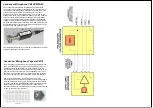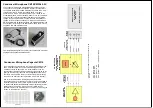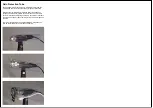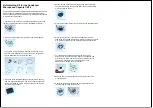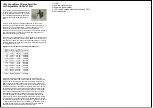
UltraSoundGate Charge Amplifier
with adjustable Hi-Pass Filter
The UltraSoundGate Charge Amplifier can
be used to connect a hydrophone directly
to the an UltraSoundGate xx16x main unit.
The integrated adjustable high-pass filter
allows rejecting unwanted low-frequency
noise.
The gain of the charge amplifier depends both on the nominal
capacitance of the connected hydrophone and the selected input
capacitance of the amplifier (Gain = 20 log (capacitance of the
hydrophone / selected input capacitance)). A hydrophone
capacitance of 3nF and an input capacitance of 1nF would provide a
gain of approximately 10 dB. The alternate input capacitance of
100pF would rise the gain to 30 dB.
The black rotary knob selects the cut-off frequency of the high-pass
filter. The filter attenuation is 6dB / octave below the selected cut-off
frequency. The labels are valid for an input capacitance of 1nF. If the
alternate 100pF setting has been selected, all frequency labels must
be multiplied by factor 10.
Care should be taken while connecting the hydrophone to the
charge amplifier. Under some circumstances it is possible that the
hydrophone or its cable have been electrostatically charged with
high voltages (several thousands volts). These high voltages may
damage the sensitive input stage of the amplifier (ESD). In order to
maintain the maximum possible sound quality (low noise), there is
no full ESD protection circuit at the amplifier input. Therefore, the
hydrophone and its cable should be discharged before connecting
them to the charge amplifier. This can be done by short-circuiting
the hydrophone connector. Additionally, the amplifier should be
switched off (either by disconnecting the amplifier from the USG
main unit or by disconnecting the USG device from the PC) before
connecting the hydrophone cable and the input impedance should
be reduced by selecting a high cut-off frequency (greater than about
1 kHz). Once the hydrophone is connected to the amplifier, there is
no further danger because any potential high voltages would be
terminated by the internal resistors of the amplifier.
High-pass cut-of frequencies and input impedances
1: GND
2: positive signal output
3: negative signal output
4: +5V supply voltage (should not exceed 5.5V)
5: not connected
rotary
switch
setting
cut-off
frequency at
1nF
cut-off
frequency at
100 pF (*)
input impedance
10
10 Hz
100 Hz
15 MOhm
25
25 Hz
250 Hz
6.8 MOhm
50
50 Hz
500 Hz
3,3 MOhm
100
100 Hz
1 kHz
1.5 MOhm
250
250 Hz
2.5 kHz
680 kOhm
500
500 Hz
5 kHz
330 kOhm
1k
1 kHz
10 kHz
150 kOhm
2.5k
2.5 kHz
25 kHz
68 kOhm
5k
5 kHz
50 kHz
33 kOhm
10k
10 kHz
100 kHz
15 kOhm
25k
25 kHz
250 kHz
6.8 kOhm
50k
50 kHz
500 kHz
3.3 kOhm



